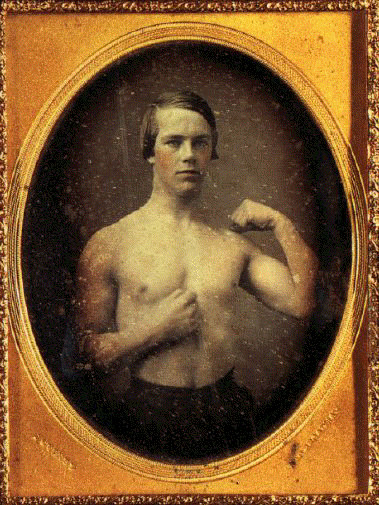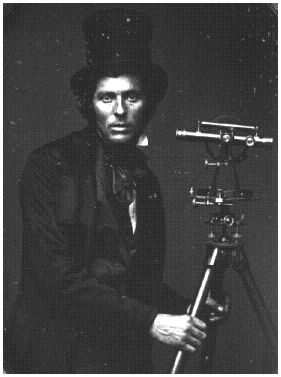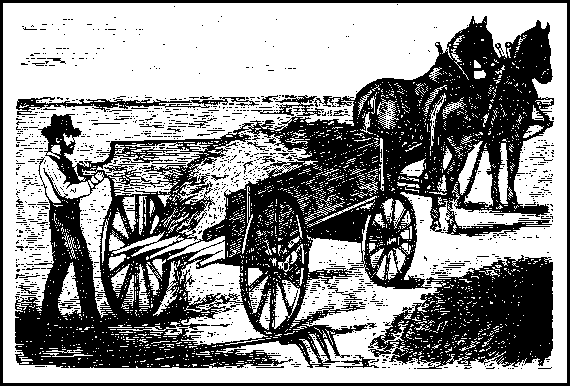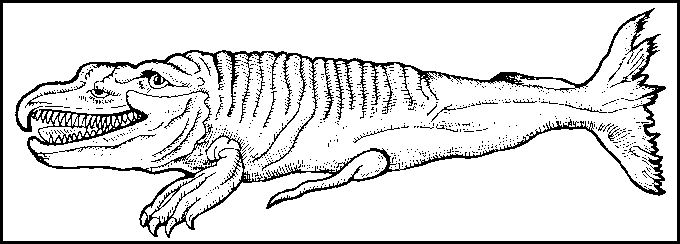The Daguerreotype
Edited by
John Wood
(University of Iowa)
 Eight authors describe eight different aspects of the daguerreotype which, editor Wood points out have been with us for 150 years. He speaks of the great simplicity of the form, that it bespeaks "lack of artifice" and "archetypal rawness," much like the poetry of Walt Whitman. Because America was a relatively rich country, these pictures could be massed produced with a professionalism lacking in other countries. In fact, in the middle of the century, 400,000 were produced in 1855 in the state of Massachusetts alone.
Eight authors describe eight different aspects of the daguerreotype which, editor Wood points out have been with us for 150 years. He speaks of the great simplicity of the form, that it bespeaks "lack of artifice" and "archetypal rawness," much like the poetry of Walt Whitman. Because America was a relatively rich country, these pictures could be massed produced with a professionalism lacking in other countries. In fact, in the middle of the century, 400,000 were produced in 1855 in the state of Massachusetts alone.Wood goes on to tell us that because of its purity, daguerreotypes are, in truth, quite modern --- with a "pure description," with content "left to the laws of chance." Much of its power has to do, he says, with the human face, "a riddle to be solved through a look..."
The face is the dynamo of desire --- and repulsion as well. It can generate lust or loathing before the mouth has shaped a syllable.
Neurologists tell us that there is a portion of the brain dedicated solely to recognizing and descrying faces. And this, according to Wood, must be why it is the center of focus of art ancient and modern.
This is a fine collection. There are twenty-eight color plates and over 150 black-and-white reproductions. There are country scenes, pictures of stores and banks, churches, waterfalls, ships, government buildings --- but, truly, the most fascinating are the faces, especially faces of the dead.
In the chapter Sex, Death and Daguerreotypes, author David Stannard begins with a quote from Susan Sontag to the effect that all photographs are momento mori because to photograph captures a moment, freezes it, and thus we "participate in another person's mortality..." Stannard describes the images of the dead --- real pictures, not fake --- from the 19th century, mostly of children. He reminds us that over the centuries, depictions of the dead have been common. We find them in Egyptian and Roman tombs and, perforce, the millions of depictions of the crucified Christ are nothing but an often stylized momento mori.
Tomb portraits and sculptures were universal in Europe, but it was the combination in 19th century America with its rural cemeteries and the importation of the techniques of producing the daguerreotype that brought about the surge in actual, real (we almost said "real live") portrayal of the dead.
 For the poor, a statue or a monument was prohibitively expensive; but, for two dollars, one could have a portrait of the deceased, what Stannard describes as "a finely rendered clarity of minutiæ...an unambiguous and unblinking representation of the portrayed individual's uniqueness as a singular human being with a singular personality --- a singular personality, in the case of the postmortem daguerreotype, that tragically has ceased to exist."
For the poor, a statue or a monument was prohibitively expensive; but, for two dollars, one could have a portrait of the deceased, what Stannard describes as "a finely rendered clarity of minutiæ...an unambiguous and unblinking representation of the portrayed individual's uniqueness as a singular human being with a singular personality --- a singular personality, in the case of the postmortem daguerreotype, that tragically has ceased to exist."
There are a half-a-dozen of these corpse-shots included, mostly of children, some with grieving parents posed carefully above the tiny body. By-the-bye, Daguerreotypes were named after the inventor, one L. J. M. Daguerre. Daguerre means of the war. Close your eyes right now: if you spell "Daguerreotype" correctly (no cheating) you get a free subscription to RALPH.
Of Howard Hughes
Clifford Irving
(terrificbooks)
Salinger
A Biography
Paul Alexander
(Renaissance Media)
Hughes, it was said, lived on the top floor of a hotel he owned in Las Vegas, grew his hair and fingernails to Chinese Mandarin lengths, and downed massive doses of codeine. However, when a fake autobiography appeared on the scene, he and his lawyers let the world know that he was very much alive.
Salinger, it's reported, lives in a tiny town in New Hampshire, and only comes out of his shell when he sees the picture of a sexy young thing on the cover of The New York Times Magazine, or when someone has the bad taste to dig up his old stories out of The Saturday Evening Post --- dreadful WWII short fiction with names like "The Last Day of the Last Furlough." Like Hughes, at times like these his lawyers charge onto the scene, letting us all know, at the very least, that he's still alive and kicking.
Many years ago, my beloved Mumsie read Catcher in the Rye. She was appalled by the school life that it depicted. She asked me what I thought of the book. "I thought it was very funny," I said. And it was. The horror of Pencey Prep was lost on me, and on most of my friends, because we were right in the middle of it.
The story of how one of the students at Pencey was driven to suicide by his peers went over my head because at the school I went to, rough hazing was so commonplace that we didn't even feel the need to comment on it. It's like asking a very poor person what it feels like to be poor. Since they are dealing with it every day, the question becomes meaningless.
It was very democratic, by the way --- this torturing of students. I remember one afternoon coming down the stairs of Hamill House and there in the hallway was the captain of the wrestling team beating up on Nicolas Kulukundis. For some reason I paused and told Ed Lawson that he should stop doing whatever he was doing to this very shy and very awkward Greek. Lawson paused in his work, told me that if I didn't shut up, he was going to pound my head --- pointing --- "into that wall over there." I shut up.
Kulukundis' father, I found out later, owned most of the shipping fleet in post-war Greece and, even to this day, I often catch myself hoping that Nicholas will one day remember fondly how I had saved him from mayhem and reward me with a tanker or so.
Salinger is a dandy writer who made many of us feel not-so-alone in the drear, dry 50s. We knew we had what he called "craziness" --- a bit juvenile, a bit Zen --- and, in our bleak post-pubescence, we found a writer who talked to us: talked our language, with characters like Holden, and Franny, and Zooey, and Esmé. A spare and very funny language it was, too.
Paul Alexander, the humbug who cranked out this biography of Salinger, reminds me a bit of Ed Lawson --- being a bully, one who's always trying to "get" someone. He just can't seem to figure out that Jerome David Salinger is a person who prefers being left alone. He isn't interested in appearing on Oprah or the Jay Leno Show, to talk about his life and his loves. Many of us admire him greatly for his writing, and --- since we despair at the current, noxious confusion between the artist and the art --- we admire him equally for his reticence. It is, truly, an unwillingness to exploit himself. He is, if you will, the shadow-opposite of Norman Mailer.
In Alexander's first chapter, "A Sighting," we don't see Salinger. Rather, we get to see Alexander, the original Ivy League Groupie, unwilling, unable to leave a man alone --- to the point of skulking around Salinger's house in New Hampshire, poking through the garbage can, sneaking a peek in the mailbox. And not only is Alexander a noisome spy, he also has what we used to call "delusions of grandeur."
"What I felt," he sighs, "was that as I was watching the house someone inside it was watching me."
Yeah. Hoping like hell this lunk would go away.
In 1933, Gertrude Stein published The Autobiography of Alice B. Toklas. It was the life story of the woman she had loved and lived with for so long. It's a winsome book, an affectionate portrait of not only Toklas, but of Stein pretending to be Toklas, and thus giving us a Chinese Box portrait of the two of them. It's only in the last line that the name of the true author is revealed.
In 1972, the writer Clifford Irving decided to do the same with Howard Hughes. But was a bit different than the Toklas/Stein work. For one thing, Irving didn't live with --- and presumably didn't love --- Hughes. It was, instead, a con job of the first water, a totally fabricated piece of chicanery --- one which finally caused the reclusive subject of the book to rise up in wrath. Irving got salted away in the hoosegow for a couple of years for his troubles, and the Autobiography was never published. At least, not until now, a quarter-century after the fact.
Hughes was obviously an interesting, driven, perhaps tortured person (anyone who has a jillion dollars and yet chooses to get strung out on codeine clearly has some issues to deal with.) But the fictionalized account that comes to us from Irving's hand presents us with a ho-hum braggart; a repetitive, arrogant, fop; a lout with a penchant for the pretty skirt. No wonder Hughes was so miffed. How would you like some ham-fisted second-rate scribbler making up your autobiography wholecloth?
The scandal is not that Irving fabricated it; the scandal is that he had such lousy insight into the character, works, and peculiarities of Hughes --- and that he did such a puerile job with whatever facts he could dig up or make up. In response to a purported question about Hughes' purported affair with Jean Harlowe, Clifford has his doppelganger say:
If you want to know whether or not I had an affair with her, the answer is yes. I went to bed with her because she was the star and I was the director and in those days it was one of the obligatory things to do. She came to my office one evening after the shoot and asked me to read some lines with her. I did that, of course, and the next thing I knew she was down on her knees, unbuttoning my fly.
Somehow --- just somehow --- it's hard to picture one of the most bold, original, and wealthy adventurers in America telling some second-rate fraud about a ho-hum blow-job that took place forty years before. As they say in English literature, it just don't parse.
Irving only got two-and-a-half years in the Greybar Hotel for his efforts. It should have been much more. We suspect that if the judge had been forced to read through the whole of this pastry-pot, Irving would have gotten twenty-five years to life. For botching what could have been, after all, a great picaresque novel.
Appliances and
How to Make Them
A Classic of
American
Ingenuity
George A. Martin
(The Lyons Press)
According to the publisher, they are handy, and "they all work." No washing machines, tractors, or motor-driven pumps here. Simple directions for a simpler life. Dennis Boyles, who introduces Farm Appliances, says,
...there is a sense of design integrity. Take, for instance, the milking stool described herein. Turned one way, to face a cow, it performs its task admirably. Turn it the other way so you're facing a pond filled with catfish, and a whole new use of the stool quickly becomes apparent.
A simpler time, indeed --- one in which an instruction manual would tell farmers not to waste grease, "for a good lubricator costs enough to keep the average man from allowing it to waste." (The author preferred castor oil, mixed with refined coal-oil, or lard, for his axles, and, perhaps, for massages.) The item shown below is an old fashioned Manure Wagon Box.

Honey,
Mud,
Maggots
And Other
Medical Marvels
Robert and Michèle
Root-Bernstein
(Mariner)
